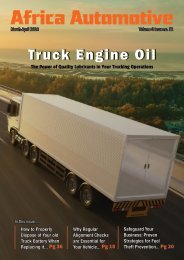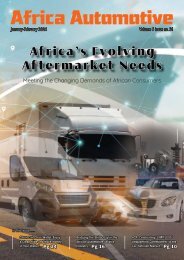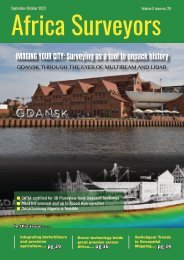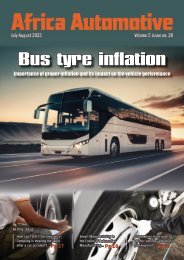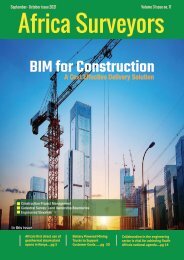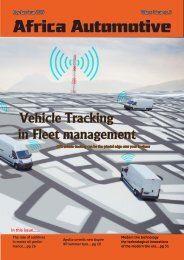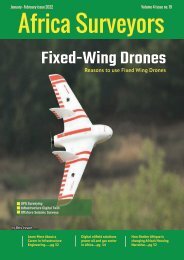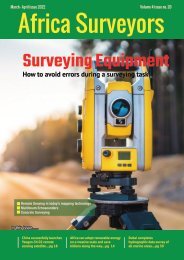Africa Automotive News September-October digital issue 2019
Africa Automotive prides itself to be the ONLY Africa’s leading and MOST authoritative magazine for the automotive industry in Africa with printed copies for the automotive industry decision makers in both government, NGO’s and private sector. The Bi-monthly magazine offers cost effective advertising services that get results and improves growth in the auto B2C and B2B sector, keeping an eye on latest technologies in Africa and across the world, the magazine predominately covers the developments in the Africa auto industry.
Africa Automotive prides itself to be the ONLY Africa’s leading and MOST authoritative magazine for the automotive industry in Africa with printed copies for the automotive industry decision makers in both government, NGO’s and private sector. The Bi-monthly magazine offers cost effective advertising services that get results and improves growth in the auto B2C and B2B sector, keeping an eye on latest technologies in Africa and across the world, the magazine predominately covers the developments in the Africa auto industry.
Create successful ePaper yourself
Turn your PDF publications into a flip-book with our unique Google optimized e-Paper software.
Feature<br />
is to nurturing a domestic industry, so<br />
is establishing a manufacturing base.<br />
South <strong>Africa</strong> leads the continent’s auto<br />
manufacturing sector with original<br />
equipment manufacturers, longestablished<br />
in the country and backed<br />
by a vibrant community of 500 suppliers<br />
and diversified manufacturers. Yet, head<br />
up the continent and there is little auto<br />
manufacturing until North <strong>Africa</strong>, bar light<br />
manufacturing from imported kits.<br />
Kenya only has three assembly plants,<br />
and they all produce vehicles with wholly<br />
imported parts that require no domestic<br />
manufacturing input.<br />
The Kenyan government, which has<br />
identified the auto sector as a key driver<br />
of the country’s industrialisation policy,<br />
has promised incentives to encourage<br />
a local industry. These include building<br />
special economic zones which benefit<br />
from tax holidays and low utility rates.<br />
It has also introduced local input<br />
requirements and tariffs on imported auto<br />
components that could be manufactured<br />
locally. Encouragingly, the assembly of<br />
motor vehicles in Kenya grew by 31.4%<br />
from 2013 to 2014, with assembly<br />
figures forecast to almost double between<br />
2013 and <strong>2019</strong>. It’s improving the<br />
country’s chances of becoming a hub for<br />
assembly and production in the region.<br />
It’s a similar story in Nigeria, where the<br />
<strong>Automotive</strong> Industry Development Plan<br />
(NAIDP) pledges to build auto industry<br />
infrastructure including supplier parks and<br />
clusters. Tax incentives include Nigeria<br />
allowing car groups to import two fullybuilt<br />
units at a discount duty of 35% for<br />
cars and 20% for commercial vehicles, for<br />
every one built locally. The government<br />
also aims to boost skills and investment<br />
and encourage a local component<br />
industry to supply manufacturers at<br />
competitive prices. It amounts to the<br />
kinds of incentives that encouraged Ford<br />
to begin assembling its Ford Ranger<br />
pickup in the Nigerian city of Ikeja in<br />
2015, partnering with Ford dealer group<br />
Coscharis Motors on the project.<br />
“Nigeria is a priority market for us in<br />
Sub-Saharan <strong>Africa</strong> and this will allow<br />
us to better serve our customers, both<br />
from a retail point of view and in terms<br />
of vehicle and parts availability,” says<br />
Jeff Nemeth, president and CEO of<br />
Ford Motor Company of Sub-Saharan<br />
<strong>Africa</strong>. “We are committed to supporting<br />
Nigeria’s developing automotive industry<br />
and economy together with Coscharis,<br />
and are looking forward to being active<br />
in the community. New assembly<br />
operations, even on a smaller scale like<br />
this one, have very positive ripple effects<br />
in the local economy and workforce.”<br />
But nurturing indigenous manufacturing<br />
is still difficult. Nigeria-based groups<br />
Nissan and Peugeot also only assemble<br />
the bulk of their vehicles from imported<br />
semi-knocked down (SKD) kits because<br />
there is no local manufacturing industry.<br />
Even Nigeria’s own Innoson Vehicle<br />
Manufacturing Company (IVM) based<br />
in the south-eastern Anambra state,<br />
assembles trucks and buses with<br />
completely knocked-down (CKD) kits<br />
with all the vehicles’ engines, gear boxes<br />
and electrical parts imported from<br />
overseas. Auto-related imports into<br />
Nigeria accounted for around 11.5% of<br />
total imports, worth around US$6.9bn in<br />
2014, according to UNCTAD.<br />
<strong>Automotive</strong> sector in <strong>Africa</strong><br />
Nigerian policy is currently making things<br />
even more difficult. Like all manufacturing,<br />
the auto sector is struggling under<br />
currency policies and associated import<br />
controls set up to conserve hard currency<br />
and encourage local manufacturing by<br />
prioritising strategic imports. It’s starving<br />
the auto sector of inputs and leading to a<br />
collapse in supplies of product lines from<br />
glass to rubber. OICA estimates that total<br />
new vehicle sales in Nigeria dropped by<br />
more than half in 2017, compared to<br />
2016. It’s this kind of foreign exchange<br />
controls that are also limiting the ability<br />
of companies to import SKD units<br />
and parts for assembly and repair in<br />
Ethiopia, where high taxes also make cars<br />
unaffordable for most.<br />
Exporting within <strong>Africa</strong> is also a challenge<br />
for the continent’s carmakers because of<br />
tariffs and barriers. Uganda and Tanzania<br />
slap tariffs on cars assembled in Kenya,<br />
the only country in the East <strong>Africa</strong>n<br />
Community with assembly capability,<br />
because they don’t meet local input<br />
criteria. It gives imported second-hand<br />
cars the edge.<br />
In recent times, Toyota South <strong>Africa</strong> saw a<br />
fall in exports to the rest of the continent<br />
as a result of higher tariffs in Nigeria,<br />
Algeria and Angola. Meanwhile, South<br />
<strong>Africa</strong> exports more vehicles to Europe,<br />
the US and even Asia than it does to its<br />
neighbouring <strong>Africa</strong>n market.<br />
“Vehicle exports to Europe and Asia<br />
continued to show growth. Vehicle<br />
exports to <strong>Africa</strong>n markets recorded<br />
substantial declines. This was due to a<br />
combination of factors including ad hoc<br />
24 <strong>Africa</strong> <strong>Automotive</strong> <strong>News</strong> l <strong>2019</strong> <strong>September</strong>-<strong>October</strong> <strong>issue</strong> l <strong>2019</strong>




